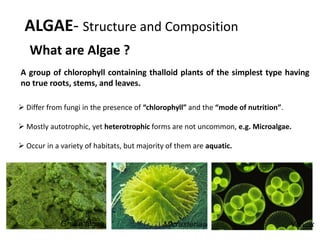
Tawqir Bashir (Lecture 11)_MB.pdf
- 1. ALGAE- Structure and Composition What are Algae ? A group of chlorophyll containing thalloid plants of the simplest type having no true roots, stems, and leaves. Differ from fungi in the presence of “chlorophyll” and the “mode of nutrition”. Mostly autotrophic, yet heterotrophic forms are not uncommon, e.g. Microalgae. Occur in a variety of habitats, but majority of them are aquatic. Micrasterias Volvox Green algae
- 2. Occurrence and Classification… Based on the habitat of occurrence- three groups: I) Aquatic algae, II) Terrestrial algae, & III) Algae of unusual habitats. 1) Fresh water forms: Occur in low salinity water of ponds, pools, lakes, and rivers. Some occur in slow running water (Cladophora, Oedogonium, Ulothrix, Chara; while others occur in stagnant water (Chlamydomonas, Volvox and Spirogyra). 2) Marine forms: Occur in saline water of sea (Ectocarpus, Saragassum, Fucus). I) AQUATIC ALGAE: Cladophora Chara Chlamydomonas Spirogyra Ectocarpus Saragassum Fucus Ulothrix
- 3. Aquatic algae are either free-floating or attached to a substratum through an attachment disk “holdfast”. Many free-floating algae together with similar organisms form colonies on the surface- “water blooms or algal blooms”. Attached to rocks along the edges/bottom of lakes and seas- “phytobenthos”. II) TERRESTRIAL ALGAE: Algae occur in terrestrial habitats like soils, rocks, logs. Some are found on the surface of soil (Vaucheria, Botrydium, Euglena)- “Saphophytes”, where as many blue-green algae occur under the surface of soil (Nostoc, Anabaena)- “Cryptophytes” Some algae are found on tree trunks and moist walls absorbing CO2 and water from the atmosphere (Protococus sp). Vaucheria Botrydium Euglena Protococus Nostoc
- 4. III) ALGAE OF UNUSUAL HABITATS: 1) Halophytic algae: Can withstand high concentration of salt and occur in salt lakes e.g. Chlamydomonas ehrenbergii, Stephanoptera. 2) Epiphytic algae: They grow on larger algae or on bryophytes and angiosperms e.g. species of Oedogonium and Microspora are found attached to the larger species of Cladophora and Vaucheria. 3) Epizoic algae: Many algae grow on animals like snails, fishes e.g. Cladophora crispata grows on snails and Stigeoclonium sp are found in the gills of fishes. 4) Endozoic algae: Occur in the tissues of animals. About 15 species of blue-green algae occur in the respiratory and digestive tracts of vertebrates. 5) Symbiotic algae: Several members of Chlorophyceae and Cyanophyceae form symbiotic association with fungi, bryophytes, gymno- & angiosperms e.g. Lichens. Chlamydomonas ehrenbergii Cladophora crispata Lichens
- 5. 6) Cryophytic algae: Algae growing on ice or snow. These provide attractive colors to snow covered mountains e.g. alpine/arctic mountains become red due to the growth of Haemotococus nivalis, green due to Chlamydomonas yellowstonensis. 7) Lithophytic algae: Many blue-green algae growing on moist rocks and stones e.g. Nostoc, Rivularia, grow on moist and shady rocks. 8) Parasitic algae: Algae also grow as parasites on many plants and animals e.g. Cephaleuros virescens causes “red rust” in tea and coffee plants in Assam. 9) Thermophytes: Many blue-green algae are found in hot water springs (50-70°C) where normal life is very difficult e.g. Oscillatoria bervis. Haemotococus nivalis Cephaleuros virescens (red rust) Oscillatoria bervis
- 6. Thallus structure in Algae… Vegetative structure of algae shows wide variety ranging from unicellular to complex multicellular thalli. Size ranges from 1μ to several meters - (5 groups). I) UNICELLULAR Forms: Found in all groups except Charophyceae and Phaeophyceae. Classified into three sub-groups: 1) Rhizopodial unicells: Lack a rigid cell wall, possess cytoplasmic projections which help them in amoeboid movements. These forms are ‘periplastic’ e.g. Rhizochrysis, Rhizochloris. Rhizochrysis 2) Flagellated unicells: Found in all groups except Cyanophyceae, Phaeophyceae and Rhodophyceae. Show similarity with motile gametes and zoospores. Number and type of flagella may vary e.g. Chlorophyceae (2 equal flagella), Xanthophyceae (2 unequal flagella). 3) Spiral filamentous unicells: Some algae form spiral or coiled structures e.g. Spirulina. 2 equal flagella Spirulina
- 7. II) COLONIAL Forms: Colonial habit is achieved by aggregation of the products of cell division within a mucilaginous mass, by aggregation of motile cells or juxtaposition of cells subsequent to cell divisions. All members of a colony have similar structure. These associations are usually loose. In some forms, all members are connected by cytoplasmic connections- hence don’t break into segments e.g. Volvox. Based on morphology and colonial organization- four types. 1) Coenobial: A colony with a definite shape, size and arrangement of cells is called “Coenobium”. Number of cells is determined at the juvenile stage followed by only increase in size. Coenibia may be motile (Volvox, Eudorina) or non-motile (Hydrodictyon). Hydrodictyon 2) Palmelloid: The number, shape and size of cell is not definite. Cells remain irregularly aggregated within a common mucilaginous matrix – are independent and function as individuals (Tetraspora). Tetraspora
- 8. 3) Dendroid: Here the colony looks like a “microscopic tree”. Number, shape and size of cells is indefinite, but a mucilaginous thread is present at the base of each cell and threads of different cells are united to form a branched structure (Chrysodendron). 4) Rhizopodial: In this type the cells are united through rhizopodia (Chrysidiastrum). Chrysodendron Chrysidiastrum III) FILAMENTOUS Forms: Formed by repeated transverse division of cells. Daughter cells don’t separate & remain attached in a definite sequence forming a ‘filament’. 1) Unbranched filaments: Found only in few groups. Filaments are free floating forming a colony (Nostoc, Oscillatoria). 2) Branched filaments: Formed by repeated transverse divisions of lateral outgrowths of cells (Cladophora). Nostoc Cladophora
- 9. IV) SIPHONACEOUS Forms: Here the thallus is made up of branched, aseptate, coenocytic, tubular filaments as the nuclear divisions are not accompanied by wall formation e.g. Vaucheria, Botrydium. IV) PARENCHYMATOUS Forms: In this type the flat, foliose or tubular thalli are formed by the division of cells in two or more planes. The daughter cells do not separate from the parent and give rise to “parenchymatous thalli” of various shapes e.g. flat (Ulva), tubular (Scytosiphon), complex (Sargassum). Vaucheria Ulva